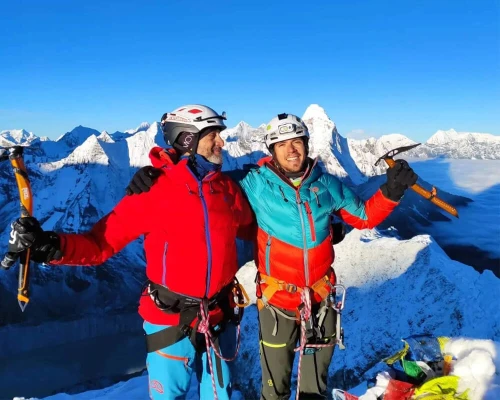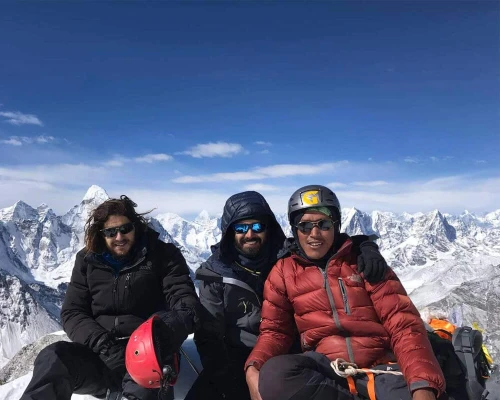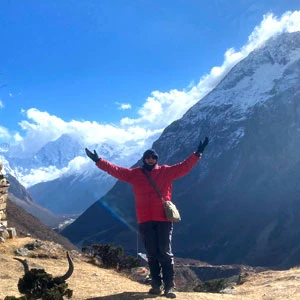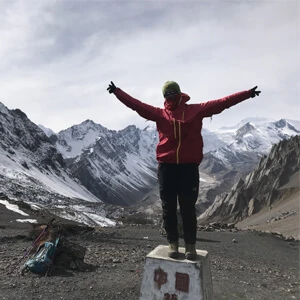Everest Base Camp with Island Peak Climbing Overview
Climbing represents the ultimate adventure in Nepal, both a touchstone to the glorious days of Mallory and Hillary and a reflection of the fact that the Himalayan giants stand as the preeminent mountaineering challenge in the world. For those who wish to sample such an exhilarating experience, Island Peak offers one of the premier climbs available to trekkers, and it's an option Nepal Trekking Experts is well placed to deliver via our many years of working in the industry. What makes this climb even more worthwhile is the bonus of being able to visit Everest Base Camp along the way. If standing on such historic and famous ground isn't enough to impel you to the top of Island Peak, nothing will! The trek also helps climbers acclimate to the altitude and build up their fitness en route, an important point for those who may be lacking somewhat in conditioning.
A 35-minute flight from Kathmandu to Lukla takes us to the start of our adventure, the classic trek to Everest Base Camp via Namche, Tengboche, and Lobuche. From there, we continue to Kala Patthar and the site of our base camp on the lower slopes of Island Peak to prepare ourselves for the excitement ahead.
Island Peak, or Imja Tse as it's known to locals, is a breathtaking climb that can be attempted from either the base camp (4,970 meters) or the high camp (5,600 meters) along a natural line that leads over a narrow ridge to the summit and its magnificent views of Everest and Lhotse. To stand atop Island Peak and behold the magnificent panorama and cloud base below is to feel like you're standing on top of the world—it's a very special moment.
Whether visiting on an individual basis or as a group, Nepal Trekking Experts has the expertise to arrange your Island Peak Climbing experience, so why not contact us and let our staff get you on the trail to the mountain's base camp?
In addition, you may also choose our similar climbing packages, such as the Lobuche Peak Climbing, Mera Peak Climbing, or the Everest Three High Passes Trek with Island Peak Climbing.
Island Peak Summit Difficulty
The Trek to Everest Base Camp combined with Island Peak Summit Trek is a moderately challenging adventure that requires a high level of physical fitness and mental determination. The first EBC trek is itself considered moderate with 12 days of trekking through of daily hikes of around 6 hours. The trek takes you through a variety of terrains, including rocky paths, suspension bridges, and steep ascents, all while dealing with the effects of high altitude.
Adding Island Peak to the trek not only increases the difficulty but also adds full of excitement to the journey. Island Peak stands at 6,189 meters above sea level. The trekking peak is classified as 2B as it consists of a few technical aspects. The ascent involves navigating tough terrain, including glacier travel and a steep headwall that requires the use of fixed ropes, crampons, ice axes, jumars, carabiners, etc. The physical demands are intensified by the need to carry climbing gear and the reduced oxygen levels at high altitudes.
Best Time For Adventure Trek to Island Peak
More than decades of experience in tourism and after completing many thousands of successful trekking and peak climbing trips, we have concluded that Spring and Autumn are the best seasons for these adventures. But why? Let us explain.
Spring Season (March to May)
The season right after winter brings a greenery charm to the Everest region. Spring offers moderate temperatures ranging from 0°C to 20°C during the day and chilly nights 0°C to negative 20°C. The skies are generally blue and free of clouds, with excellent visibility of the Himalayan peaks. Additionally, newly grown plants and flowers, such as rhododendrons, add vibrant colors to the landscape. The best part is you get to encounter the diverse flora and fauna along the trail of Everest
Autumn Season (September to November)
Following the heavy rainfall of the monsoon season, autumn indeed brings stable, clear weather with low precipitation. Temperatures are mild 0°C to 15°C during the day and 0°C to negative 20°C at night. Due to the clear atmosphere, the views of the Himalayan peaks are exceptional. The landscape takes on the charm of the autumn season, with colorful foliage adding to the picturesque scenery.
Moreover, autumn is the time for some of the biggest festivals in the region, such as Teej, Dashain, Tihar, Chad, etc. These festivals gives a unique opportunity for trekkers and climbers to immerse themselves in Hindu culture and traditions.
EBC with Island Peak Climbing Permit Cost
For the Trek to Everest Base Camp and climb to Island Peak, you will need to obtain several permits, each with its own cost:
Everest Base Camp Trek Permit Costs:
- Sagarmatha National Park Entry Permit: NPR 3000 per person.
- Khumbu Pasang Lhamu Rural Municipality Permit: NPR 2000 per person.
Island Peak Climbing Permit Costs:
- Spring (March–May): USD 250 per person.
- Autumn (September–November): USD 125 per person.
- Winter (December–February): USD 70 per person.
- Summer (June–August): USD 70 per person.
How can I book the Island Peak High Altitude Climbing?
To book your trek with us, you have to send a 10% deposit of the total cost. Please also forward a copy of your passport, a passport-sized photo, and full flight details if and when available. For your convenience, you may forward the deposit online through our website. It is completely safe, and as soon as you make it, you will get an automatic receipt in your inbox. The rest of the payment can be paid upon arrival.
.webp)

.webp)



 based on 1 review
based on 1 review



